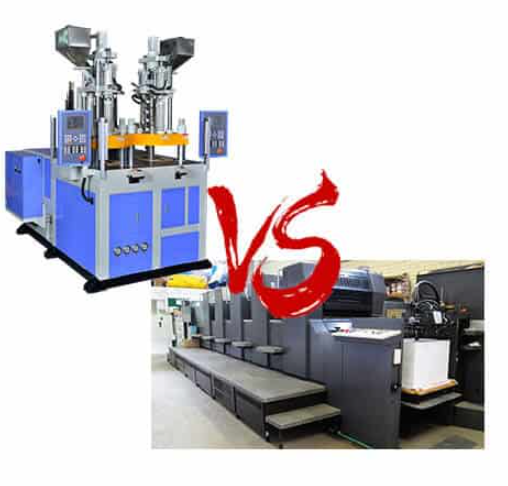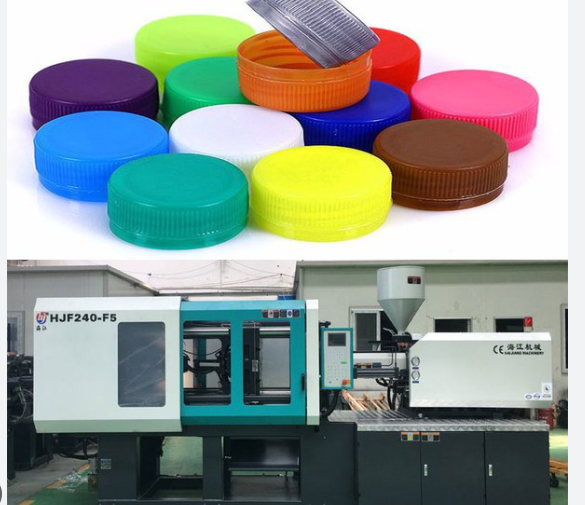The main difference lies in the orientation and applications of the machines, affecting space, efficiency, and maintenance.
Overview of Injection Molding Machines
Injection molding machines play a crucial role in manufacturing by shaping plastic into various products. This process involves melting plastic granules and injecting them into a mold under high pressure. Once the plastic cools and solidifies, the mold opens to eject the finished product.

Basic Principles of Injection Molding
Injection molding starts with feeding plastic pellets into the machine’s hopper. A screw mechanism then moves these pellets towards the heating chamber, where they melt. The molten plastic, now in a liquid state, gets injected into a mold cavity through a nozzle. The pressure and speed of this injection are precisely controlled to ensure the quality and consistency of the final product. The plastic cools down and solidifies, taking the shape of the mold.
Key aspects of this process include temperature control and pressure application. The temperature must be high enough to melt the plastic but not so high as to degrade its quality. The applied pressure needs to be strong enough to fill the mold completely but also precise to avoid defects in the product.
Components of Injection Molding Machines
An injection molding machine comprises several essential components:
- Hopper: The starting point where plastic pellets are loaded.
- Heating Chamber: A section where the plastic pellets are melted.
- Screw Mechanism: It pushes the melted plastic towards the mold.
- Nozzle: This part injects the molten plastic into the mold.
- Clamping Unit: It holds the mold in place during the injection and cooling phases.
- Control Panel: A sophisticated system to manage the process parameters like temperature, pressure, and injection speed.
Vertical Injection Molding Machines
Vertical injection molding machines are specialized equipment used in the plastic manufacturing industry. They stand out due to their vertical arrangement, which differs from the more common horizontal machines.
Design and Operation
The design of vertical injection molding machines involves a vertically oriented clamping unit and an injection unit. This vertical alignment allows gravity to assist in the process of inserting and removing parts. The operation begins with the placement of a mold in the machine. Plastic pellets are then fed into a heating chamber, where they melt. The molten plastic is injected vertically into the mold cavity. After cooling and solidification, the part is ejected, and the process repeats.
One key feature of these machines is their smaller footprint, making them ideal for facilities with limited space. However, their power consumption can vary, typically depending on the machine size and complexity. For instance, machines designed for larger parts consume more power.
Applications and Material Compatibility
Vertical injection molding machines are versatile and compatible with a wide range of materials, including thermoplastics like ABS, polycarbonate, and polypropylene. They are particularly well-suited for insert molding, a process where components such as metal inserts are placed into the mold before the injection of plastic. This capability is invaluable for manufacturing electrical components, automotive parts, and medical devices.
The efficiency of these machines in handling different materials makes them a valuable asset in various sectors. The cost and quality of output depend on the type of material used and the machine’s specifications.
Advantages and Limitations
One of the primary advantages of vertical injection molding machines is their ability to perform insert molding efficiently. They also offer greater flexibility in mold design due to their open clamping system. These machines often have a lower initial cost compared to horizontal machines, making them a cost-effective option for small-scale production.
Horizontal Injection Molding Machines
Horizontal injection molding machines are widely used in the manufacturing industry, primarily due to their efficiency and versatility in producing a wide range of plastic products.
Design and Operation
Horizontal injection molding machines feature a horizontal clamping unit and an injection unit. In this setup, plastic pellets are fed into a hopper, melted in a heating chamber, and then injected into a horizontally held mold. Key parameters in this process include the injection pressure, clamping force, and the temperature, which can range from 200°C to 400°C depending on the material used.
These machines are typically larger in size and consume more power, with some models requiring up to 15 kW of power. The cost of these machines varies, with high-end models costing upwards of $100,000, depending on their size and capabilities.
Applications and Material Compatibility
Horizontal injection molding machines are suitable for a wide array of applications, including automotive parts, consumer goods, and electronic components. They are compatible with a diverse range of materials, from common plastics like polyethylene and polypropylene to engineering plastics like polycarbonate and polyamide.
Their versatility in handling various materials and complex mold designs makes them a staple in large-scale production. The machines’ capability to produce parts with intricate designs and high precision adds to their widespread use.
Advantages and Limitations
One of the major advantages of horizontal machines is their ability to handle large production volumes efficiently. The automation in these machines also minimizes human error, enhancing the quality and consistency of products. They offer faster cycle times, which translates to higher production speeds.
However, they also have some limitations. Their larger size requires more floor space, and their initial cost can be a significant investment for small businesses. The horizontal design might also pose challenges in terms of manual intervention for insert molding or removal of finished products.
Comparative Analysis
In this section, we compare vertical and horizontal injection molding machines across different parameters such as space requirements, precision, control, and ease of operation and maintenance. The information is organized in a tabular format for clarity.
Space Requirements and Layout
| Aspect | Vertical Injection Molding Machines | Horizontal Injection Molding Machines |
|---|---|---|
| Footprint | Smaller footprint, ideal for limited space. | Larger footprint, requires more floor space. |
| Layout Flexibility | Suitable for constrained spaces due to vertical design. | Less flexible, requires ample space for operation. |
Vertical machines are advantageous in facilities with space constraints, while horizontal machines need more area but are suitable for large-scale production.
Precision and Control in Molding
| Aspect | Vertical Injection Molding Machines | Horizontal Injection Molding Machines |
|---|---|---|
| Precision | High precision in insert molding. | Superior precision in large-scale production. |
| Control | Manual control in part insertion/removal, affecting consistency. | Automated control, enhancing consistency and quality. |
Horizontal machines offer better precision and control, especially in automated and large-scale manufacturing environments.
Ease of Operation and Maintenance
| Aspect | Vertical Injection Molding Machines | Horizontal Injection Molding Machines |
|---|---|---|
| Operation | Easier manual intervention for insert molding. | Automated processes, less manual intervention. |
| Maintenance | Accessible parts for maintenance. | Maintenance can be more challenging due to size. |
| Cost of Maintenance | Generally lower due to simpler design. | Higher due to complexity and size. |
Selecting the Right Machine for Your Needs
Choosing the appropriate injection molding machine is crucial for efficient and cost-effective manufacturing. The decision hinges on multiple factors, each impacting the overall productivity and financial viability of your production process.

Assessing Production Requirements
When assessing production requirements, consider the following:
- Part Size and Complexity: Larger or more complex parts may require horizontal machines for better precision.
- Production Volume: High-volume production typically benefits from the efficiency of horizontal machines.
- Material Used: Certain materials might be better suited to the specific pressure and temperature controls of either machine type.
- Space Availability: If space is limited, a vertical machine may be more appropriate.
- Labor Skill Level: Consider the skill level of operators, as vertical machines might require more manual intervention.
Cost-Benefit Analysis
A thorough cost-benefit analysis should include:
- Initial Investment: Horizontal machines usually have a higher initial cost compared to vertical machines.
- Operating Costs:
- Power Consumption: Horizontal machines often consume more power, impacting long-term operational costs.
- Maintenance Costs: Vertical machines might have lower maintenance costs due to their simpler design.
- Production Efficiency:
- Cycle Time: Horizontal machines typically have shorter cycle times, increasing output.
- Waste Reduction: Efficient use of materials reduces waste, which can be a significant cost factor.
- Return on Investment (ROI): Estimate the time it will take for the machine to pay for itself through increased production or cost savings.
- Resale Value: Consider the potential resale value of the machine as technology advances.




